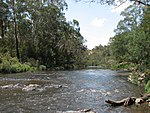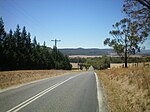Brushy Creek (Melbourne)
Melbourne Water catchmentMelbourne geography stubsRivers of Greater Melbourne (region)Tributaries of the Yarra RiverVictoria (state) river stubs
Brushy Creek is a tributary of the Yarra River in Melbourne. The creek rises in Mooroolbark Heights and passes through a mixture of underground channels and floodways through the east of Mooroolbark, until it returns to an open waterway through central Mooroolbark. From Mooroolbark it continues downstream through Croydon and passes under the Maroondah Highway, where it flows through Croydon North, Chirnside Park and Wonga Park until it joins the Yarra River in the Warrandyte State Park.
Excerpt from the Wikipedia article Brushy Creek (Melbourne) (License: CC BY-SA 3.0, Authors).Brushy Creek (Melbourne)
Reserve Road, Melbourne Wonga Park
Geographical coordinates (GPS) Address Nearby Places Show on map
Geographical coordinates (GPS)
| Latitude | Longitude |
|---|---|
| N -37.71766 ° | E 145.28547 ° |
Address
Reserve Road
3115 Melbourne, Wonga Park
Victoria, Australia
Open on Google Maps





